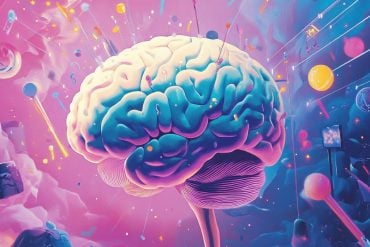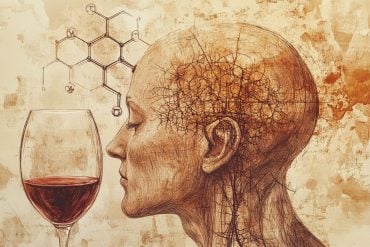Summary: HIV infection leads to increased EIF2 signaling in microglia, astrocytes, and neurons. Study reveals how HIV infection and some antiretrovirals affect cognition and the central nervous system.
Source: University of Pennsylvania
Though many negative repercussions of human immunodeficiency virus infection can be mitigated with the use of antiretroviral therapy (ART), one area where medical advances haven’t made as much progress is in the reduction of cognitive impacts. Half of HIV patients have HIV-associated neurocognitive disorders (HAND), which can manifest in a variety of ways, from forgetfulness and confusion to behavior changes and motor deficiencies.
To better understand the mechanisms underlying HAND, researchers from Penn’s School of Dental Medicine and Perelman School of Medicine and from the Children’s Hospital of Philadelphia (CHOP) brought together their complementary expertise to create a laboratory model system using three of the types of brain cells thought to be involved. Led by doctoral student Sean Ryan, who was co-mentored by Kelly Jordan-Sciutto of Penn Dental Medicine and Stewart Anderson of CHOP and Penn Medicine, the model recapitulates important features of how HIV infection and ART affect the brain.
“Frankly the models we generally use in the HIV field have a lot of weaknesses,” says Jordan-Sciutto, co-corresponding author on the paper, which appears in the journal Stem Cell Reports. “The power of this system is it allows us to look at the interaction between different cell types of human origin in a way that is more relevant to patients than other models.”
In addition to studying HIV, members of the team plan to use the same model to shed light on the neurological mechanisms that underlie other conditions, such as schizophrenia, Alzheimer’s, and even normal aging.
“We’re collaborating with a variety of colleagues to use this system to study Alzheimer’s disease as well as schizophrenia,” says Anderson, co-corresponding author on the paper. “We have the components in a dish that we know are interacting in these diseases, and this gives us a new mix-and-match way to understand how certain cells are contributing to neuronal damage.”
Indeed, the impetus to create the model grew not out of HIV research but work that Ryan was pursuing in Anderson’s lab on schizophrenia.
“We had been looking at the role of microglia, the resident immune cells of the central nervous system,” says Ryan, first author on the work. “We wanted to see if we could see the mechanistic changes that occur with microglia in schizophrenia.”
To do so, Ryan and Anderson were interested in using human-induced pluripotent stem cells–adult cells that are reprogrammed to resemble embryonic stem cells–which can be coaxed into differentiating into a variety of different cell types.
But schizophrenia is a complicated disease with a variety of contributing genetic and environmental factors and a broad spectrum of presentations. Rather than looking at something complex, they sought to apply their new system to a disease that likewise causes neurological damage but does so in a more dramatic way and in which microglia are also implicated: HIV/AIDS infection.
They reached out to Jordan-Sciutto, who has deep experience investigating the mechanisms of HAND and was eager for the opportunity to develop a model superior to those currently available. Together, the scientists identified the three cell types they were most interested in studying: neurons, astrocytes, and microglia.
Neurons aren’t directly infected by HIV but are known to be damaged during infection. Meanwhile astrocytes are believed to interact with neurons, causing damage by sending pro-inflammatory factors into the spaces between cells, called synapses. And microglia, which are responsible for maintaining a healthy environment in the absence of disease, are seen to expand and contribute to inflammation during HIV infection.
After nailing the technical challenge of creating this tractable model in which each cell type is generated independently and then mixed together, the team used it to probe how HIV infection and ART impact the cells, both alone and in combination.
“A lot of people are taking PreEP [pre-exposure prophylaxis] if they’re in a situation where their risk of contracting HIV is heightened,” says Ryan. “Just as we want to understand the cognitive impacts of HIV, we also want to see whether these drugs alone are impacting the brain health of otherwise healthy people.”
The researchers looked at RNA expression in their cultures to get a sense of what proteins and signaling pathways were becoming activated in each scenario. During infection, they saw inflammatory pathways that had previously been implicated in HIV in earlier research. When they introduced the antiretroviral drug EFZ, which is not in common use in the United States but remains a frontline therapy in many other areas of the world, with an infection, the activity of most of these pathways was reduced.
“But this scenario involved its own unique response,” says Ryan. Certain pathways associated with inflammation and damage remained despite the introduction of EFZ.
“EFZ treatment of the tri-cultures that included HIV-infected microglia reduces inflammation by around 70%,” Ryan says. Interestingly, EFZ by itself also triggered inflammation, though to a lesser extent than infection.
“It seems a combination of infection and ART is creating its own unique response that is different from the sum of its parts,” Ryan says. “Knowing what pathways are still active due to ART could help us appropriately target additional therapies so patients don’t develop HAND.”

Many features of infection seen in the three-cell culture mirror what is known from HIV infection and ART treatment in people, giving the researchers confidence in the reliability of their model.
“Just looking at the microglia,” says Anderson, “we see in our system that they are taking on both of their normal roles in keeping key signaling systems balanced during their normal state and activating and causing damage when they’re fighting infection. We’re able to model normality and abnormality in a way we haven’t been able to before.”
For Jordan-Sciutto, the new system “is really going to change the way my lab operates going into the future.” She’s hopeful many other HIV scientists will take it up to further their studies as she also explores more aspects of HIV’s impact on the brain, such as how it navigates through the blood-brain barrier that normally protects the central nervous system from inflammation and infection.
The study authors give credit to the collaborative environment at Penn for this cross-disciplinary project. “Tentacles of this project extend from CHOP to the dental school to the vet school to the medical school,” says Anderson. “Penn is a very special place where people seem to be more likely to share their technologies around and let other people work with and develop them. This project is a great example of that.”
Kelly L. Jordan-Sciutto is vice chair and professor in the Department of Basic and Translational Sciences in Penn’s School of Dental Medicine, associate dean of graduate education, and director of biomedical graduate studies at the Perelman School of Medicine.
Stewart A. Anderson is director of research in the Department of Child and Adolescent Psychiatry and Behavioral Services at the Children’s Hospital of Philadelphia and a professor of psychiatry at the Perelman School of Medicine.
Sean K. Ryan was a graduate student in Penn’s Cell and Molecular Biology Graduate Group in the Genomics and Epigenetics program, co-mentored by Jordan-Sciutto and Anderson. He is now a postdoctoral researcher at the Perelman School of Medicine.
Jordan-Sciutto, Anderson, and Ryan’s coauthors on the study were CHOP’s Michael V. Gonzalez, James P. Garifallou, Nathaniel P. Sotuyo, Kieona Cook, and Hakon Hakonarson; Penn Medicine’s Frederick C. Bennett and Eugene Mironets; and Spelman College’s Kimberly S. Williams.
Funding: The research was supported by the National Institute of Neurological Disorders and Stroke (Grant NS107594), Penn Center for AIDS Research, and Penn Mental Health AIDS Research Center.
Source:
University of Pennsylvania
Media Contacts:
Katherine Unger Baillie – University of Pennsylvania
Image Source:
The image is in the public domain.
Original Research: Open access
“Neuroinflammation and EIF2 Signaling Persist despite Antiretroviral Treatment in an hiPSC Tri-culture Model of HIV Infection”. Sean Ryan at al.
Stem Cell Reports doi:10.1016/j.stemcr.2020.02.010.
Abstract
Neuroinflammation and EIF2 Signaling Persist despite Antiretroviral Treatment in an hiPSC Tri-culture Model of HIV Infection
Highlights
• Describes a tri-culture of hiPSC-derived microglia, astrocytes, and neurons
• HIV infection leads to increased EIF2 signaling in all three cell types
• Efavirenz treatment alone creates an inflammatory signature by RNA expression
• Infected iMicroglia increased inflammation response and reduced synaptophagocytosis
Summary
HIV-associated neurocognitive disorders (HAND) affect over half of HIV-infected individuals, despite antiretroviral therapy (ART). Therapeutically targetable mechanisms underlying HAND remain elusive, partly due to a lack of a representative model. We developed a human-induced pluripotent stem cell (hiPSC)-based model, independently differentiating hiPSCs into neurons, astrocytes, and microglia, and systematically combining to generate a tri-culture with or without HIV infection and ART. Single-cell RNA sequencing analysis on tri-cultures with HIV-infected microglia revealed inflammatory signatures in the microglia and EIF2 signaling in all three cell types. Treatment with the antiretroviral compound efavirenz (EFZ) mostly resolved these signatures. However, EFZ increased RhoGDI and CD40 signaling in the HIV-infected microglia. This activation was associated with a persistent increase in transforming growth factor α production by microglia. This work establishes a tri-culture that recapitulates key features of HIV infection in the CNS and provides a new model to examine the effects of infection, its treatment, and other co-morbid conditions.






